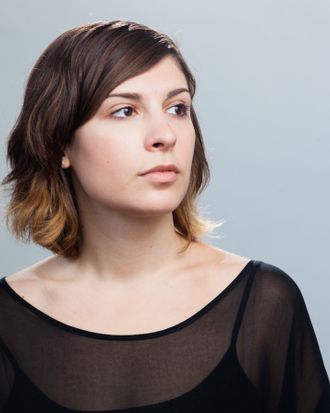
On a recent Saturday night, an ÔÇ£incubator-warmingÔÇØ party was held for New INC,┬áthe New MuseumÔÇÖs mimic of a start-up hub for art, tech, and design. Amid angular Knoll and Vitra furniture alongside whiteboard wallpaper, members who pay between $350 and $600 a month (part-time and full-time, respectively) sipped on sponsored vodka-cognac cocktails mixed with Club-Mate. ÔÇ£This is what all the hackers in Berlin drink,ÔÇØ explained Gabe Liberti of Studio Indefinit, which develops sound installations, while waiting in line at the bar. ÔÇ£That was all about yesterday,ÔÇØ he offered, ÔÇ£and this is tomorrow.ÔÇØ
Tomorrow at New INC, housed on the second floor of a building wedged between the museum and the Bowery Mission, means a lot of things: 4RealÔÇÖs artist-designed web experiences for everyone from indie musicians to corporations such as Comcast; or ReifyÔÇÖs sculptural objects that can be downloaded as prerecorded sound (we canÔÇÖt wait for the Fashion Week invites!). More than half of the 60-plus members listed on New INCÔÇÖs website identify as artists, while the spaceÔÇÖs internal programming almost entirely focuses on entrepreneurial savvy. It comes as no surprise that brands are lining up to get involved. But is there a danger in artists seeking that kind of validation for the sake of drumming up business? After the party ÔÇö on the officeÔÇÖs brand-new nap-friendly couches ÔÇö we spoke with the director Julia Kaganskiy, 28, about this and what itÔÇÖs like inside the up-and-running incubator.
In one sentence, what does New INC do?
New INC is the first museum-led incubator for creative practitioners and creative entrepreneurs working at the intersection of art, design, and technology.
What is the difference between the two?
Cultural practitioners, thatÔÇÖs our artists and designers. TheyÔÇÖre usually sole practitioners trying to build their own careers. The cultural entrepreneurs are either studios┬áwho are interdisciplinary teams that may be working on anything from interactive architectural installations to creative web experiences,┬áor start-ups that are working on a product.┬áA lot of these folks are working on a path that more closely resembles start-ups at other incubators, so theyÔÇÖre raising a seed round, figuring out their investment strategy; they have a pitch deck.The cultural entrepreneurs are either studios┬áwho are interdisciplinary teams that may be working on anything from interactive architectural installations to creative web experiences,┬áor start-ups that are working on a product.
And what do you do on an average day here?
My day-to-day is a mixture of working with members, connecting them with each other and to news sources, maybe trying to figure out a PR strategy. If theyÔÇÖre having a legal question I can pull a legal adviser, or if theyÔÇÖre having a technical challenge, I can connect them with other members who can workshop their ideas. Also, connecting them with space to show or fabricate their ideas, coordinating lectures, workshops, and also encouraging skill shares and partnerships. WeÔÇÖre new; weÔÇÖre figuring out how we collaborate with other organizations and institutions. ThereÔÇÖs been a lot of inbound interest in this program, and so much of this first year is about making very strong strategic strides toward mapping out our long-term structure and establishing our brand identity.
As much as you could say, what is that brand identity now?
I dont know, its still  its hard to say from inside. What wed like to be known for is a space that brings together visionary creative thinkers who are working at this forefront of culture and technology and are investigating new models both for creative practice and also for business practice.
You told me New INC is a start-up for start-ups. What do you mean by that exactly?
We are two months old. To my knowledge, nobodyÔÇÖs ever done a program exactly like this. WeÔÇÖve spent a lot of time researching other models and are attempting to put our own spin on what this should be, and have that be informed by the people in the community weÔÇÖre working with, the context of being in New York, being on the Bowery, being at the New Museum, and also a particular type of tech landscape that New York City affords.
WeÔÇÖre figuring things out and people are excited to contribute to the creation of something. So yeah, weÔÇÖre a start-up. We were lucky enough to have a board of trustees at the museum and partners who are helping to build out this mission, but the model of New INC is an experiment for us, too, in a self-sustaining model, thatÔÇÖs why we charge membership fees that go to cover our operating expenses, so weÔÇÖre bootstrapping in a lot of ways.
I was going to ask, too, about how money comes into the equation, especially when there are people here who are paying. Usually at an incubator part of that arrangement is getting connected with VCs, et cetera. Will you do that?
Several VCs are on our advisory council  Andy Weissman and John Maeda have come in and done lectures and had one-on-ones where they talk to people in the space about their business model. Theyre not necessarily going to invest  and, in fact, as advisers it would be a conflict of interest for them to invest. We are going to do our first Demo Day in January.
I think at this point weÔÇÖre taking more of a hands-off approach in terms of facilitating those connections. WeÔÇÖre much more interested in educating our community about what it means to take investment, and what valuation and equity structures look like. Last Monday we had a session with WilmerHale, our legal partner. I think weÔÇÖll dig into that topic even more, because there was so much interest. ItÔÇÖs almost like a dark art to a certain extent, like, there is no real science or formula to why something is worth a certain amount.
I talked to people at the party about VC funding, people doing art projects with Brooks Brothers, Comcast, other big companies. I guess I would say: Is that an ideal outcome? On the artist side, weÔÇÖre moving into a period where thatÔÇÖs more and more the norm. How do you make sense of that?
Interest from brands and corporations in culture has really, IÔÇÖd say, exploded in the past few years, especially at this intersection of art and technology where you have tech companies who are looking at this new breed of technologically proficient creatives coming out, and saying, ÔÇ£WeÔÇÖd love to work with you. HereÔÇÖs our product. Can you do something interesting?ÔÇØ A lot of artists, designers, and studios who were taking on this type of work maybe arenÔÇÖt well equipped to enter into those types of conversations. ThereÔÇÖs this whole group of people who need that support to talk to the Comcasts and Brooks Brothers and the Googles of the world.
Right, itÔÇÖs a no-brainer that if youÔÇÖre a designer or you make a really amazing piece of technology that you want to be able to have those kinds of conversations. But obviously for artists, for the goal to be to do that, might not be seen as a good thing. Or is it inevitable? What is the standpoint of New INC on that?
I donÔÇÖt know that I have a clear-cut answer. So first of all, as far as New INC goes, the majority of people envisioning collaborations with brands now are more in the design category than the art category, letÔÇÖs make that distinction first and foremost. That said, out there in the world artists are getting into bed with corporations all the time. That is something that has been going on for decades and, to a certain extent, centuries. And I think if done in the right way, if structured in the right way, it is not a bad thing. Frankly, I would much rather see a brand genuinely invest in art production than I would have them spend millions of dollars on a 30-second Super Bowl spot.
You were saying about the inbound interest, and other museums may be interested in doing this now. Can you talk about that?
With New INC, we are very clearly tapping into something thatÔÇÖs part of the Zeitgeist. ItÔÇÖs something that maybe other institutions were aware of but because weÔÇÖre doing it first it gives them permission to do it. A bigger institution might not be able to be as nimble, to be as comfortable with experimentation and failure.
There was DevArt at the Barbican, but that didnÔÇÖt go so well ÔÇö
I donÔÇÖt think that program at all relates to what weÔÇÖre doing.
ÔÇö in terms of that was an example of museums trying to engage the tech world where people saw it as being sort in the interest of trendiness, or Zeitgeist for the purpose of Zeitgeist. The DevArt part of it.
The problem with the DevArt part of it wasnÔÇÖt that the institution was trying to be trendy: The partnership wasnÔÇÖt incredibly well structured, and the language that was used to present that project was one of the most problematic aspects of it. They created this new term and tried to position Google as the creators and benefactors of this new breed of artist that works with code. The people who had issues with that pointed out that artists have been working with code since the 1960s, and they felt that this was an instance of a brand co-opting and not acknowledging the legacy of this artistic output, for a marketing campaign essentially. I really donÔÇÖt think it has anything to do with what weÔÇÖre doing here.
Do you think thatÔÇÖs a danger if more institutions are trying to do this kind of work?
Absolutely. ThatÔÇÖs one of the things weÔÇÖre trying to think about: What are the boundaries? ThereÔÇÖs interest, people are working with brands, but weÔÇÖre not the ones facilitating those connections. Until we figure out a way to do that in the right way, we wonÔÇÖt be.
On the other side of that, IÔÇÖve noticed a lot of people here are engaging with the museum itself. Print All Over Me is in the window, a lot of other members have projects. ItÔÇÖs not their brand, exactly, but itÔÇÖs their platform.
ItÔÇÖs a real-life environment to test out ideas, and what IÔÇÖm hoping to do is to deepen and further those connections over time. WeÔÇÖve been bringing in curators to do critiques. We could also do some kind of visitor services experience with an app.
One area of research thatÔÇÖs kind of organically developed from the community is virtual reality. You can imagine once the platform has more robust application and adoption, you could have a virtual exhibition, and we have that here now.
The most obvious link right now seems that a couple of people have something for sale in the bookstore and gift shop, or in the window. Can you talk about that?
ItÔÇÖs a natural platform for us, especially since a lot of people here have a product, be they artists or designers. One of the members has a publication thatÔÇÖs carried in the store, itÔÇÖs called the Printed Web. Print All Over Me did a dress where Chris Ofili designed a print and it was used to create these limited-edition silk dresses that are being sold in the store. Separate from that, they are also doing a window installation. The Principals are doing a collaboration with our memberships department, so they created this limited-edition pinwheel as an artist-designed gift for members. ItÔÇÖs exciting to see so much interest from the museum as well and how they can activate this community.
This interview has been edited and condensed.


